University Case Study: Biopsychosocial Assessment of Patient Teddy
VerifiedAdded on 2022/08/29
|10
|2833
|53
Case Study
AI Summary
This case study assesses the post-operative care of Patient Teddy, focusing on the biopsychosocial, spiritual, and cultural impacts of his surgery. Teddy, an elderly patient with multiple comorbidities including diabetes, heart failure, and gout, underwent bowel resection and faces complications like nausea, vomiting, and abdominal distension. The assessment, based on the Roper Logan Tierney model, highlights the importance of considering these factors in his recovery. The case study identifies nursing problems such as acute pain, deficient fluid volume, risk of impaired skin integrity, risk for constipation, and deficient knowledge. The nursing care plan includes interventions such as pain assessment, fluid monitoring, skin integrity maintenance, bowel habit assessment, and patient education. Medication administration, including analgesics and coagulation modifiers, is discussed. The document emphasizes the need for an enhanced recovery pathway, including early feeding, pain management, and prevention of complications such as postoperative ileus. The study provides a comprehensive overview of Teddy's condition and outlines the nursing care plan, including medication administration, designed to facilitate his recovery and improve his overall well-being. The case study underscores the importance of holistic patient care in a surgical setting, emphasizing the interconnectedness of biological, psychological, social, spiritual, and cultural factors.
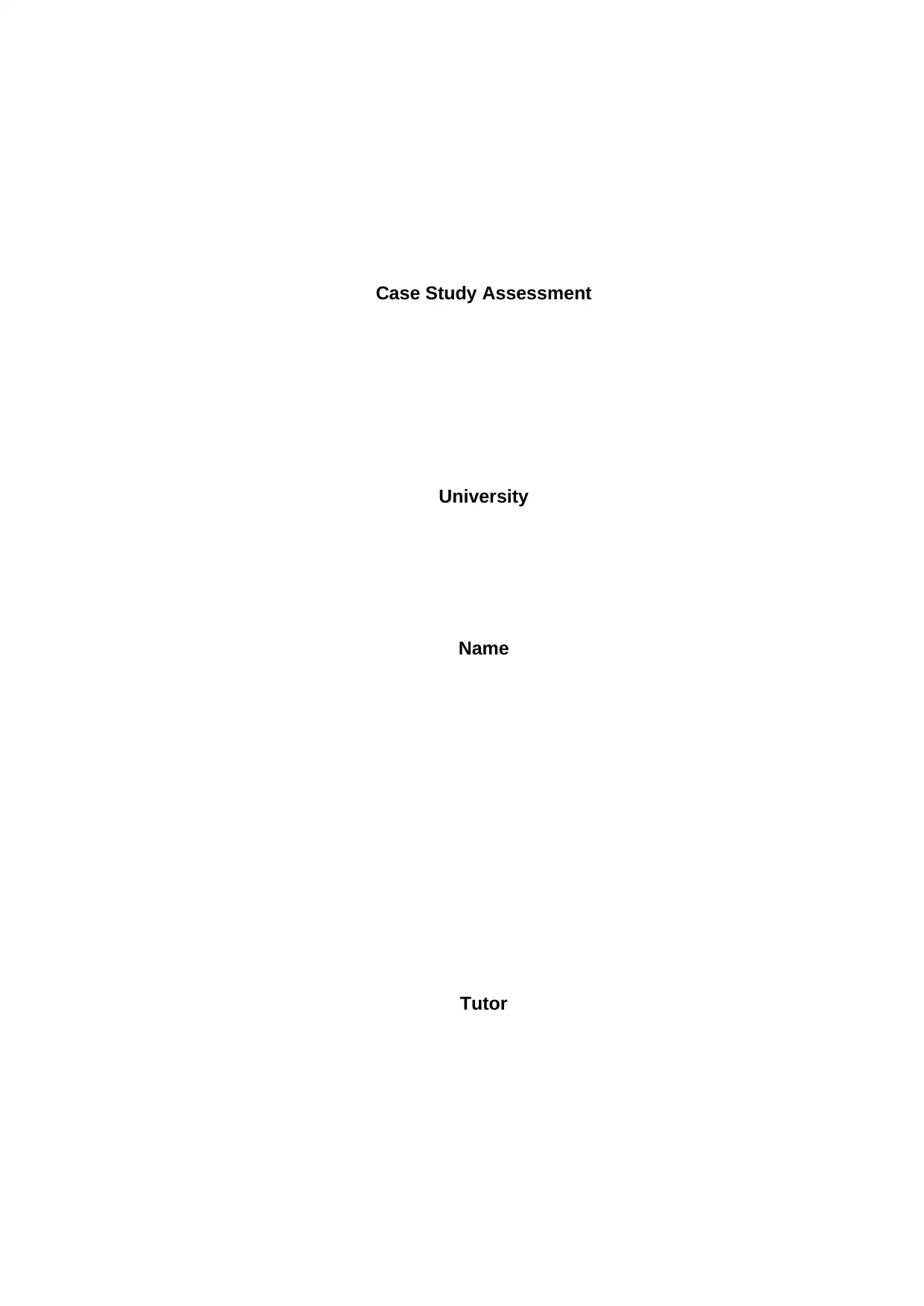
Case Study Assessment
University
Name
Tutor
University
Name
Tutor
Paraphrase This Document
Need a fresh take? Get an instant paraphrase of this document with our AI Paraphraser
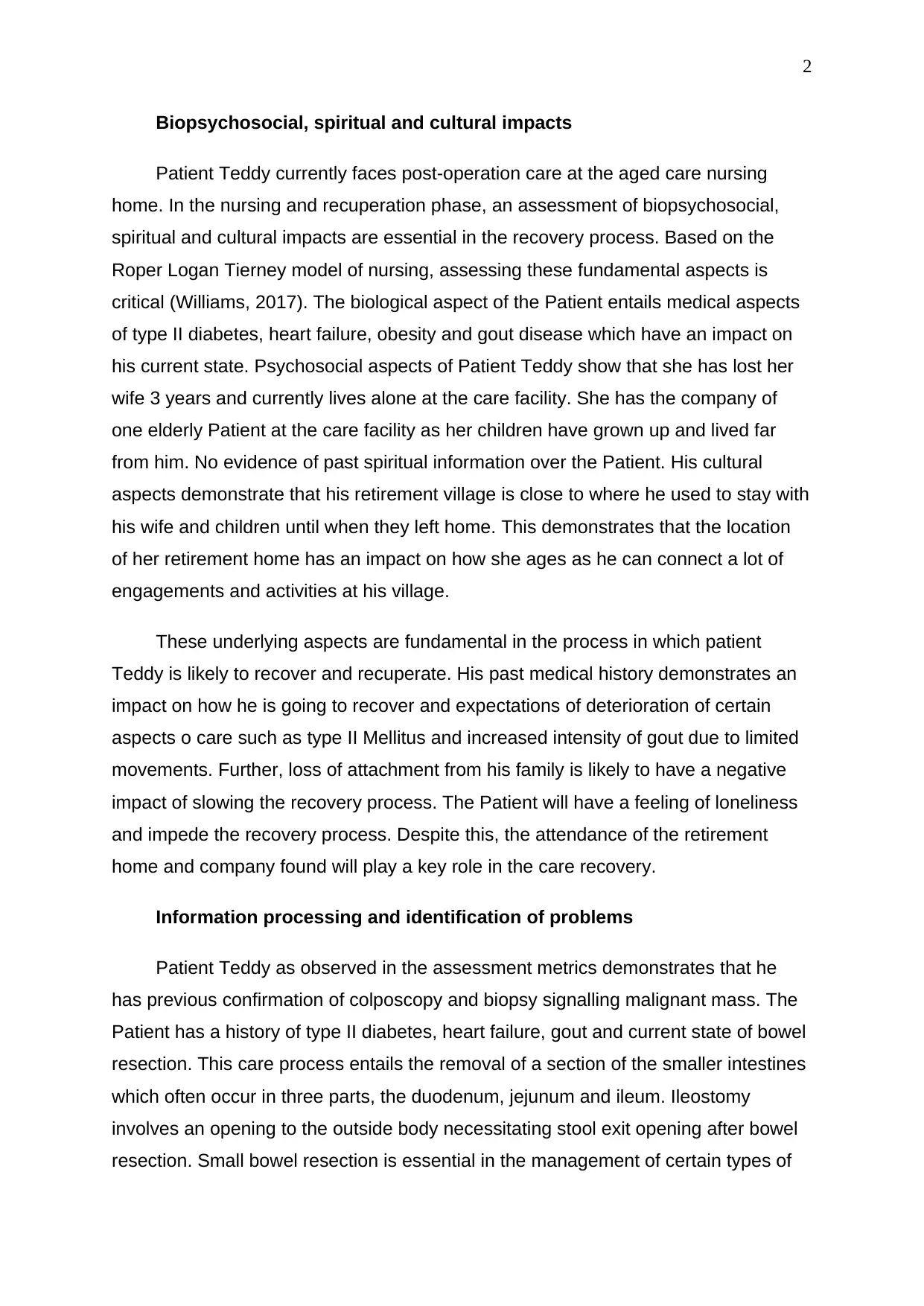
2
Biopsychosocial, spiritual and cultural impacts
Patient Teddy currently faces post-operation care at the aged care nursing
home. In the nursing and recuperation phase, an assessment of biopsychosocial,
spiritual and cultural impacts are essential in the recovery process. Based on the
Roper Logan Tierney model of nursing, assessing these fundamental aspects is
critical (Williams, 2017). The biological aspect of the Patient entails medical aspects
of type II diabetes, heart failure, obesity and gout disease which have an impact on
his current state. Psychosocial aspects of Patient Teddy show that she has lost her
wife 3 years and currently lives alone at the care facility. She has the company of
one elderly Patient at the care facility as her children have grown up and lived far
from him. No evidence of past spiritual information over the Patient. His cultural
aspects demonstrate that his retirement village is close to where he used to stay with
his wife and children until when they left home. This demonstrates that the location
of her retirement home has an impact on how she ages as he can connect a lot of
engagements and activities at his village.
These underlying aspects are fundamental in the process in which patient
Teddy is likely to recover and recuperate. His past medical history demonstrates an
impact on how he is going to recover and expectations of deterioration of certain
aspects o care such as type II Mellitus and increased intensity of gout due to limited
movements. Further, loss of attachment from his family is likely to have a negative
impact of slowing the recovery process. The Patient will have a feeling of loneliness
and impede the recovery process. Despite this, the attendance of the retirement
home and company found will play a key role in the care recovery.
Information processing and identification of problems
Patient Teddy as observed in the assessment metrics demonstrates that he
has previous confirmation of colposcopy and biopsy signalling malignant mass. The
Patient has a history of type II diabetes, heart failure, gout and current state of bowel
resection. This care process entails the removal of a section of the smaller intestines
which often occur in three parts, the duodenum, jejunum and ileum. Ileostomy
involves an opening to the outside body necessitating stool exit opening after bowel
resection. Small bowel resection is essential in the management of certain types of
Biopsychosocial, spiritual and cultural impacts
Patient Teddy currently faces post-operation care at the aged care nursing
home. In the nursing and recuperation phase, an assessment of biopsychosocial,
spiritual and cultural impacts are essential in the recovery process. Based on the
Roper Logan Tierney model of nursing, assessing these fundamental aspects is
critical (Williams, 2017). The biological aspect of the Patient entails medical aspects
of type II diabetes, heart failure, obesity and gout disease which have an impact on
his current state. Psychosocial aspects of Patient Teddy show that she has lost her
wife 3 years and currently lives alone at the care facility. She has the company of
one elderly Patient at the care facility as her children have grown up and lived far
from him. No evidence of past spiritual information over the Patient. His cultural
aspects demonstrate that his retirement village is close to where he used to stay with
his wife and children until when they left home. This demonstrates that the location
of her retirement home has an impact on how she ages as he can connect a lot of
engagements and activities at his village.
These underlying aspects are fundamental in the process in which patient
Teddy is likely to recover and recuperate. His past medical history demonstrates an
impact on how he is going to recover and expectations of deterioration of certain
aspects o care such as type II Mellitus and increased intensity of gout due to limited
movements. Further, loss of attachment from his family is likely to have a negative
impact of slowing the recovery process. The Patient will have a feeling of loneliness
and impede the recovery process. Despite this, the attendance of the retirement
home and company found will play a key role in the care recovery.
Information processing and identification of problems
Patient Teddy as observed in the assessment metrics demonstrates that he
has previous confirmation of colposcopy and biopsy signalling malignant mass. The
Patient has a history of type II diabetes, heart failure, gout and current state of bowel
resection. This care process entails the removal of a section of the smaller intestines
which often occur in three parts, the duodenum, jejunum and ileum. Ileostomy
involves an opening to the outside body necessitating stool exit opening after bowel
resection. Small bowel resection is essential in the management of certain types of
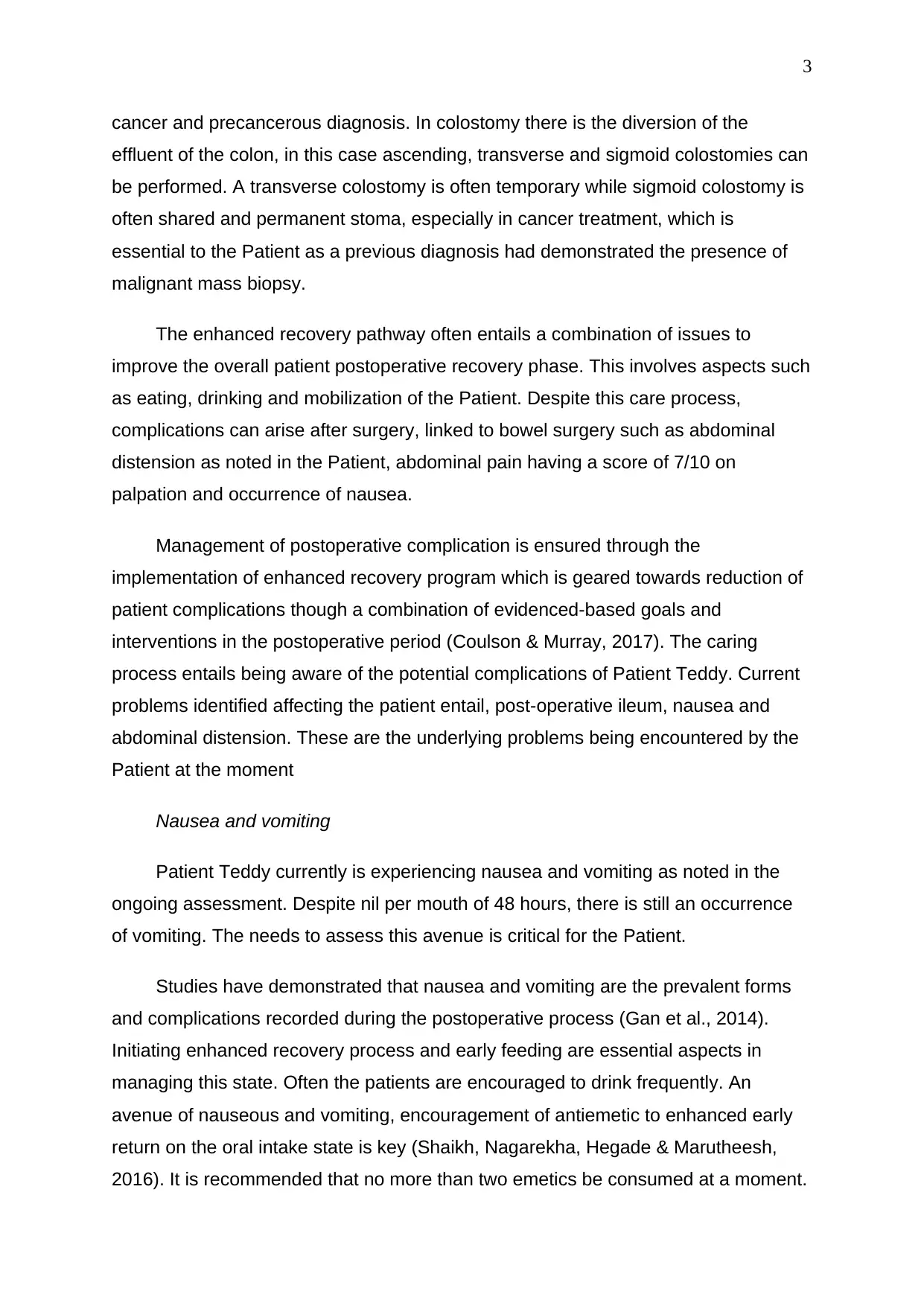
3
cancer and precancerous diagnosis. In colostomy there is the diversion of the
effluent of the colon, in this case ascending, transverse and sigmoid colostomies can
be performed. A transverse colostomy is often temporary while sigmoid colostomy is
often shared and permanent stoma, especially in cancer treatment, which is
essential to the Patient as a previous diagnosis had demonstrated the presence of
malignant mass biopsy.
The enhanced recovery pathway often entails a combination of issues to
improve the overall patient postoperative recovery phase. This involves aspects such
as eating, drinking and mobilization of the Patient. Despite this care process,
complications can arise after surgery, linked to bowel surgery such as abdominal
distension as noted in the Patient, abdominal pain having a score of 7/10 on
palpation and occurrence of nausea.
Management of postoperative complication is ensured through the
implementation of enhanced recovery program which is geared towards reduction of
patient complications though a combination of evidenced-based goals and
interventions in the postoperative period (Coulson & Murray, 2017). The caring
process entails being aware of the potential complications of Patient Teddy. Current
problems identified affecting the patient entail, post-operative ileum, nausea and
abdominal distension. These are the underlying problems being encountered by the
Patient at the moment
Nausea and vomiting
Patient Teddy currently is experiencing nausea and vomiting as noted in the
ongoing assessment. Despite nil per mouth of 48 hours, there is still an occurrence
of vomiting. The needs to assess this avenue is critical for the Patient.
Studies have demonstrated that nausea and vomiting are the prevalent forms
and complications recorded during the postoperative process (Gan et al., 2014).
Initiating enhanced recovery process and early feeding are essential aspects in
managing this state. Often the patients are encouraged to drink frequently. An
avenue of nauseous and vomiting, encouragement of antiemetic to enhanced early
return on the oral intake state is key (Shaikh, Nagarekha, Hegade & Marutheesh,
2016). It is recommended that no more than two emetics be consumed at a moment.
cancer and precancerous diagnosis. In colostomy there is the diversion of the
effluent of the colon, in this case ascending, transverse and sigmoid colostomies can
be performed. A transverse colostomy is often temporary while sigmoid colostomy is
often shared and permanent stoma, especially in cancer treatment, which is
essential to the Patient as a previous diagnosis had demonstrated the presence of
malignant mass biopsy.
The enhanced recovery pathway often entails a combination of issues to
improve the overall patient postoperative recovery phase. This involves aspects such
as eating, drinking and mobilization of the Patient. Despite this care process,
complications can arise after surgery, linked to bowel surgery such as abdominal
distension as noted in the Patient, abdominal pain having a score of 7/10 on
palpation and occurrence of nausea.
Management of postoperative complication is ensured through the
implementation of enhanced recovery program which is geared towards reduction of
patient complications though a combination of evidenced-based goals and
interventions in the postoperative period (Coulson & Murray, 2017). The caring
process entails being aware of the potential complications of Patient Teddy. Current
problems identified affecting the patient entail, post-operative ileum, nausea and
abdominal distension. These are the underlying problems being encountered by the
Patient at the moment
Nausea and vomiting
Patient Teddy currently is experiencing nausea and vomiting as noted in the
ongoing assessment. Despite nil per mouth of 48 hours, there is still an occurrence
of vomiting. The needs to assess this avenue is critical for the Patient.
Studies have demonstrated that nausea and vomiting are the prevalent forms
and complications recorded during the postoperative process (Gan et al., 2014).
Initiating enhanced recovery process and early feeding are essential aspects in
managing this state. Often the patients are encouraged to drink frequently. An
avenue of nauseous and vomiting, encouragement of antiemetic to enhanced early
return on the oral intake state is key (Shaikh, Nagarekha, Hegade & Marutheesh,
2016). It is recommended that no more than two emetics be consumed at a moment.
⊘ This is a preview!⊘
Do you want full access?
Subscribe today to unlock all pages.

Trusted by 1+ million students worldwide
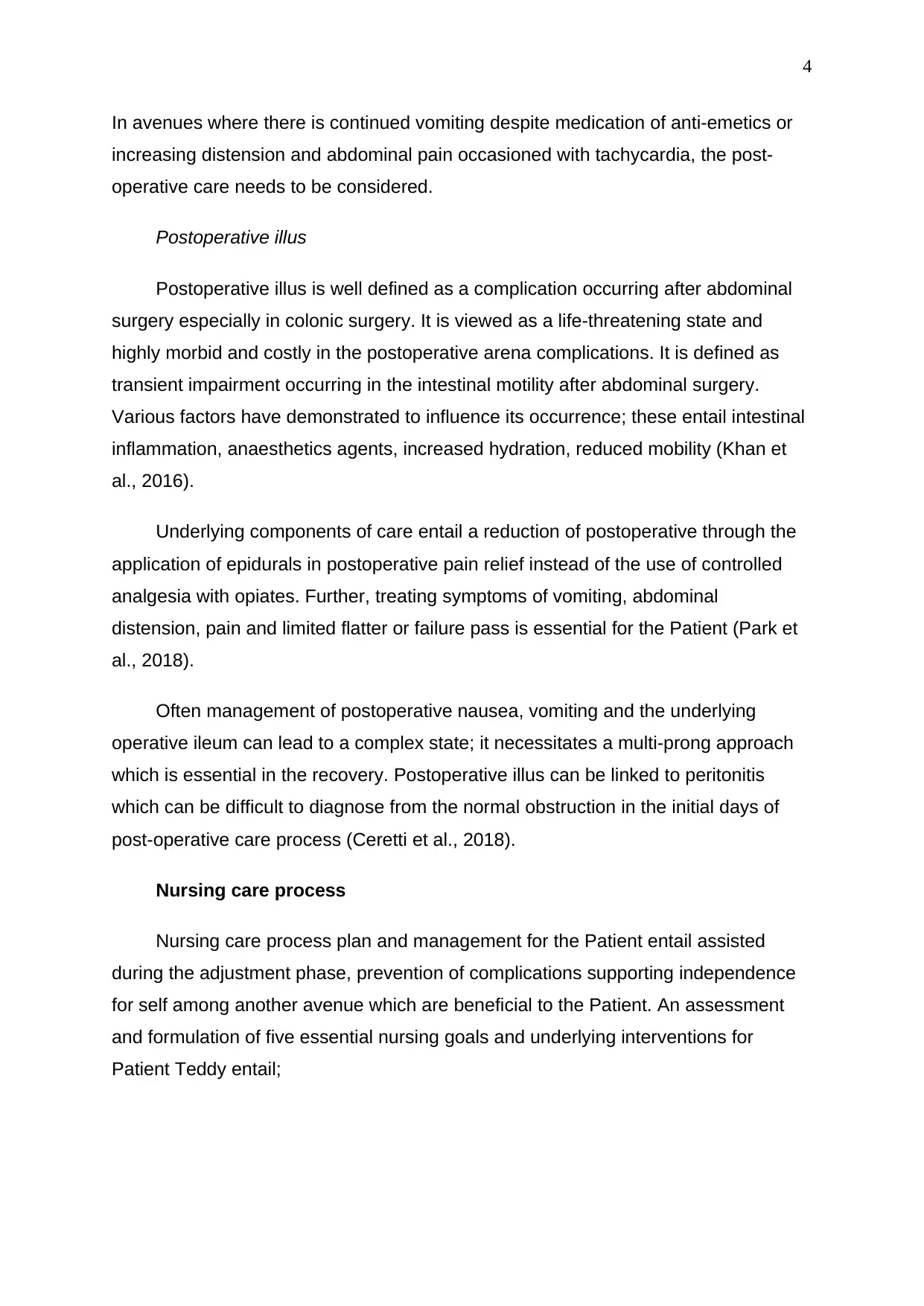
4
In avenues where there is continued vomiting despite medication of anti-emetics or
increasing distension and abdominal pain occasioned with tachycardia, the post-
operative care needs to be considered.
Postoperative illus
Postoperative illus is well defined as a complication occurring after abdominal
surgery especially in colonic surgery. It is viewed as a life-threatening state and
highly morbid and costly in the postoperative arena complications. It is defined as
transient impairment occurring in the intestinal motility after abdominal surgery.
Various factors have demonstrated to influence its occurrence; these entail intestinal
inflammation, anaesthetics agents, increased hydration, reduced mobility (Khan et
al., 2016).
Underlying components of care entail a reduction of postoperative through the
application of epidurals in postoperative pain relief instead of the use of controlled
analgesia with opiates. Further, treating symptoms of vomiting, abdominal
distension, pain and limited flatter or failure pass is essential for the Patient (Park et
al., 2018).
Often management of postoperative nausea, vomiting and the underlying
operative ileum can lead to a complex state; it necessitates a multi-prong approach
which is essential in the recovery. Postoperative illus can be linked to peritonitis
which can be difficult to diagnose from the normal obstruction in the initial days of
post-operative care process (Ceretti et al., 2018).
Nursing care process
Nursing care process plan and management for the Patient entail assisted
during the adjustment phase, prevention of complications supporting independence
for self among another avenue which are beneficial to the Patient. An assessment
and formulation of five essential nursing goals and underlying interventions for
Patient Teddy entail;
In avenues where there is continued vomiting despite medication of anti-emetics or
increasing distension and abdominal pain occasioned with tachycardia, the post-
operative care needs to be considered.
Postoperative illus
Postoperative illus is well defined as a complication occurring after abdominal
surgery especially in colonic surgery. It is viewed as a life-threatening state and
highly morbid and costly in the postoperative arena complications. It is defined as
transient impairment occurring in the intestinal motility after abdominal surgery.
Various factors have demonstrated to influence its occurrence; these entail intestinal
inflammation, anaesthetics agents, increased hydration, reduced mobility (Khan et
al., 2016).
Underlying components of care entail a reduction of postoperative through the
application of epidurals in postoperative pain relief instead of the use of controlled
analgesia with opiates. Further, treating symptoms of vomiting, abdominal
distension, pain and limited flatter or failure pass is essential for the Patient (Park et
al., 2018).
Often management of postoperative nausea, vomiting and the underlying
operative ileum can lead to a complex state; it necessitates a multi-prong approach
which is essential in the recovery. Postoperative illus can be linked to peritonitis
which can be difficult to diagnose from the normal obstruction in the initial days of
post-operative care process (Ceretti et al., 2018).
Nursing care process
Nursing care process plan and management for the Patient entail assisted
during the adjustment phase, prevention of complications supporting independence
for self among another avenue which are beneficial to the Patient. An assessment
and formulation of five essential nursing goals and underlying interventions for
Patient Teddy entail;
Paraphrase This Document
Need a fresh take? Get an instant paraphrase of this document with our AI Paraphraser
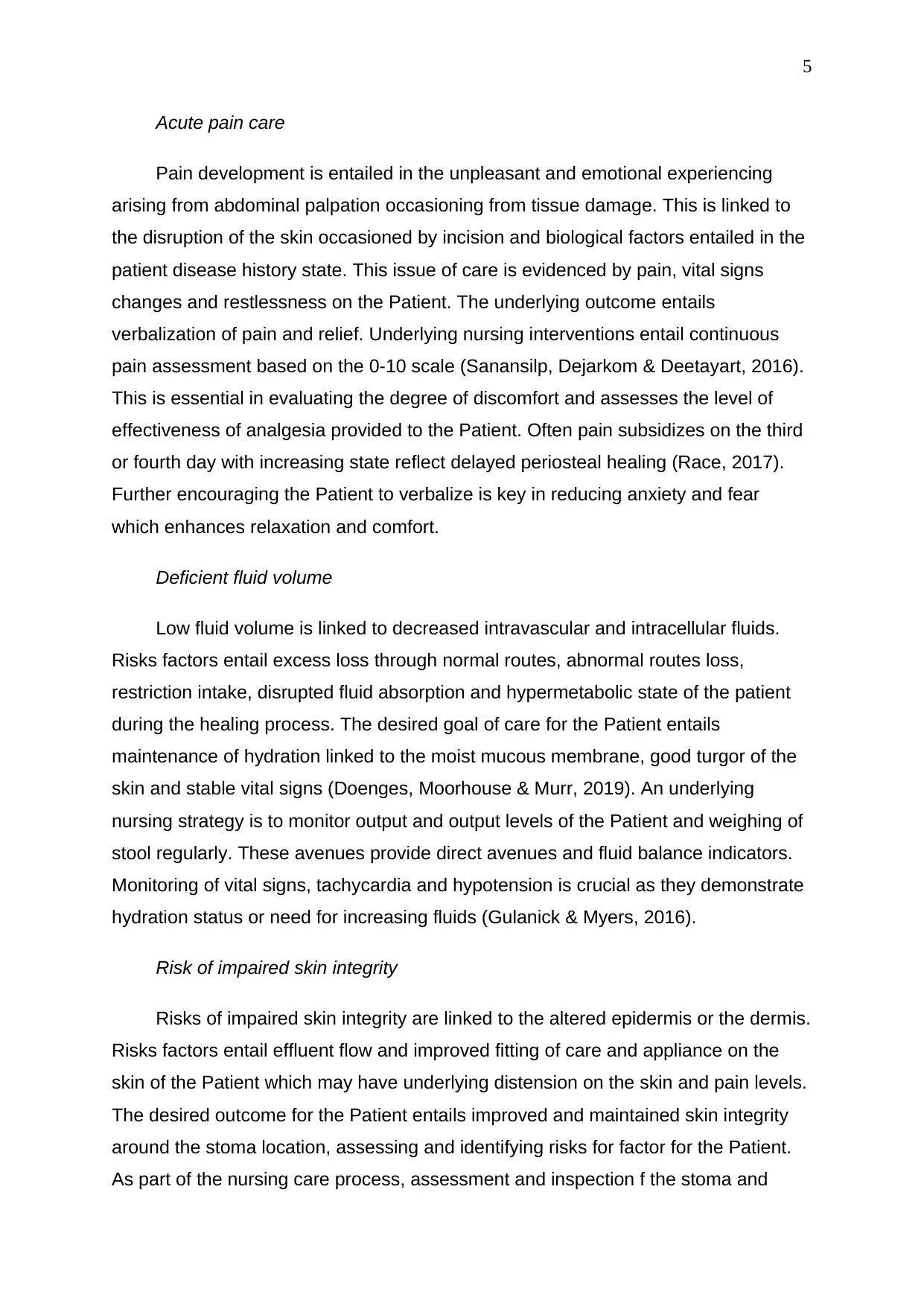
5
Acute pain care
Pain development is entailed in the unpleasant and emotional experiencing
arising from abdominal palpation occasioning from tissue damage. This is linked to
the disruption of the skin occasioned by incision and biological factors entailed in the
patient disease history state. This issue of care is evidenced by pain, vital signs
changes and restlessness on the Patient. The underlying outcome entails
verbalization of pain and relief. Underlying nursing interventions entail continuous
pain assessment based on the 0-10 scale (Sanansilp, Dejarkom & Deetayart, 2016).
This is essential in evaluating the degree of discomfort and assesses the level of
effectiveness of analgesia provided to the Patient. Often pain subsidizes on the third
or fourth day with increasing state reflect delayed periosteal healing (Race, 2017).
Further encouraging the Patient to verbalize is key in reducing anxiety and fear
which enhances relaxation and comfort.
Deficient fluid volume
Low fluid volume is linked to decreased intravascular and intracellular fluids.
Risks factors entail excess loss through normal routes, abnormal routes loss,
restriction intake, disrupted fluid absorption and hypermetabolic state of the patient
during the healing process. The desired goal of care for the Patient entails
maintenance of hydration linked to the moist mucous membrane, good turgor of the
skin and stable vital signs (Doenges, Moorhouse & Murr, 2019). An underlying
nursing strategy is to monitor output and output levels of the Patient and weighing of
stool regularly. These avenues provide direct avenues and fluid balance indicators.
Monitoring of vital signs, tachycardia and hypotension is crucial as they demonstrate
hydration status or need for increasing fluids (Gulanick & Myers, 2016).
Risk of impaired skin integrity
Risks of impaired skin integrity are linked to the altered epidermis or the dermis.
Risks factors entail effluent flow and improved fitting of care and appliance on the
skin of the Patient which may have underlying distension on the skin and pain levels.
The desired outcome for the Patient entails improved and maintained skin integrity
around the stoma location, assessing and identifying risks for factor for the Patient.
As part of the nursing care process, assessment and inspection f the stoma and
Acute pain care
Pain development is entailed in the unpleasant and emotional experiencing
arising from abdominal palpation occasioning from tissue damage. This is linked to
the disruption of the skin occasioned by incision and biological factors entailed in the
patient disease history state. This issue of care is evidenced by pain, vital signs
changes and restlessness on the Patient. The underlying outcome entails
verbalization of pain and relief. Underlying nursing interventions entail continuous
pain assessment based on the 0-10 scale (Sanansilp, Dejarkom & Deetayart, 2016).
This is essential in evaluating the degree of discomfort and assesses the level of
effectiveness of analgesia provided to the Patient. Often pain subsidizes on the third
or fourth day with increasing state reflect delayed periosteal healing (Race, 2017).
Further encouraging the Patient to verbalize is key in reducing anxiety and fear
which enhances relaxation and comfort.
Deficient fluid volume
Low fluid volume is linked to decreased intravascular and intracellular fluids.
Risks factors entail excess loss through normal routes, abnormal routes loss,
restriction intake, disrupted fluid absorption and hypermetabolic state of the patient
during the healing process. The desired goal of care for the Patient entails
maintenance of hydration linked to the moist mucous membrane, good turgor of the
skin and stable vital signs (Doenges, Moorhouse & Murr, 2019). An underlying
nursing strategy is to monitor output and output levels of the Patient and weighing of
stool regularly. These avenues provide direct avenues and fluid balance indicators.
Monitoring of vital signs, tachycardia and hypotension is crucial as they demonstrate
hydration status or need for increasing fluids (Gulanick & Myers, 2016).
Risk of impaired skin integrity
Risks of impaired skin integrity are linked to the altered epidermis or the dermis.
Risks factors entail effluent flow and improved fitting of care and appliance on the
skin of the Patient which may have underlying distension on the skin and pain levels.
The desired outcome for the Patient entails improved and maintained skin integrity
around the stoma location, assessing and identifying risks for factor for the Patient.
As part of the nursing care process, assessment and inspection f the stoma and
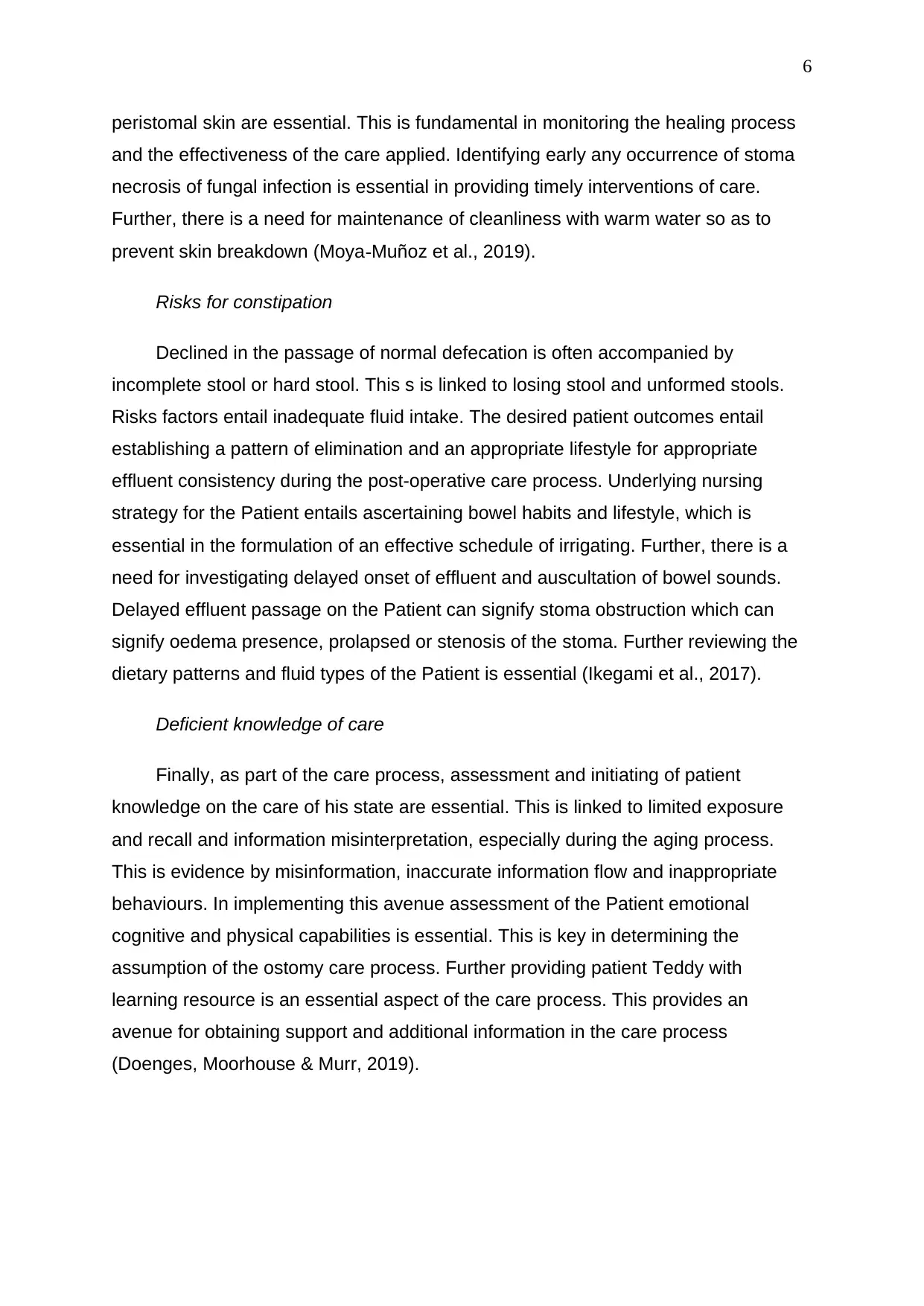
6
peristomal skin are essential. This is fundamental in monitoring the healing process
and the effectiveness of the care applied. Identifying early any occurrence of stoma
necrosis of fungal infection is essential in providing timely interventions of care.
Further, there is a need for maintenance of cleanliness with warm water so as to
prevent skin breakdown (Moya‐Muñoz et al., 2019).
Risks for constipation
Declined in the passage of normal defecation is often accompanied by
incomplete stool or hard stool. This s is linked to losing stool and unformed stools.
Risks factors entail inadequate fluid intake. The desired patient outcomes entail
establishing a pattern of elimination and an appropriate lifestyle for appropriate
effluent consistency during the post-operative care process. Underlying nursing
strategy for the Patient entails ascertaining bowel habits and lifestyle, which is
essential in the formulation of an effective schedule of irrigating. Further, there is a
need for investigating delayed onset of effluent and auscultation of bowel sounds.
Delayed effluent passage on the Patient can signify stoma obstruction which can
signify oedema presence, prolapsed or stenosis of the stoma. Further reviewing the
dietary patterns and fluid types of the Patient is essential (Ikegami et al., 2017).
Deficient knowledge of care
Finally, as part of the care process, assessment and initiating of patient
knowledge on the care of his state are essential. This is linked to limited exposure
and recall and information misinterpretation, especially during the aging process.
This is evidence by misinformation, inaccurate information flow and inappropriate
behaviours. In implementing this avenue assessment of the Patient emotional
cognitive and physical capabilities is essential. This is key in determining the
assumption of the ostomy care process. Further providing patient Teddy with
learning resource is an essential aspect of the care process. This provides an
avenue for obtaining support and additional information in the care process
(Doenges, Moorhouse & Murr, 2019).
peristomal skin are essential. This is fundamental in monitoring the healing process
and the effectiveness of the care applied. Identifying early any occurrence of stoma
necrosis of fungal infection is essential in providing timely interventions of care.
Further, there is a need for maintenance of cleanliness with warm water so as to
prevent skin breakdown (Moya‐Muñoz et al., 2019).
Risks for constipation
Declined in the passage of normal defecation is often accompanied by
incomplete stool or hard stool. This s is linked to losing stool and unformed stools.
Risks factors entail inadequate fluid intake. The desired patient outcomes entail
establishing a pattern of elimination and an appropriate lifestyle for appropriate
effluent consistency during the post-operative care process. Underlying nursing
strategy for the Patient entails ascertaining bowel habits and lifestyle, which is
essential in the formulation of an effective schedule of irrigating. Further, there is a
need for investigating delayed onset of effluent and auscultation of bowel sounds.
Delayed effluent passage on the Patient can signify stoma obstruction which can
signify oedema presence, prolapsed or stenosis of the stoma. Further reviewing the
dietary patterns and fluid types of the Patient is essential (Ikegami et al., 2017).
Deficient knowledge of care
Finally, as part of the care process, assessment and initiating of patient
knowledge on the care of his state are essential. This is linked to limited exposure
and recall and information misinterpretation, especially during the aging process.
This is evidence by misinformation, inaccurate information flow and inappropriate
behaviours. In implementing this avenue assessment of the Patient emotional
cognitive and physical capabilities is essential. This is key in determining the
assumption of the ostomy care process. Further providing patient Teddy with
learning resource is an essential aspect of the care process. This provides an
avenue for obtaining support and additional information in the care process
(Doenges, Moorhouse & Murr, 2019).
⊘ This is a preview!⊘
Do you want full access?
Subscribe today to unlock all pages.

Trusted by 1+ million students worldwide
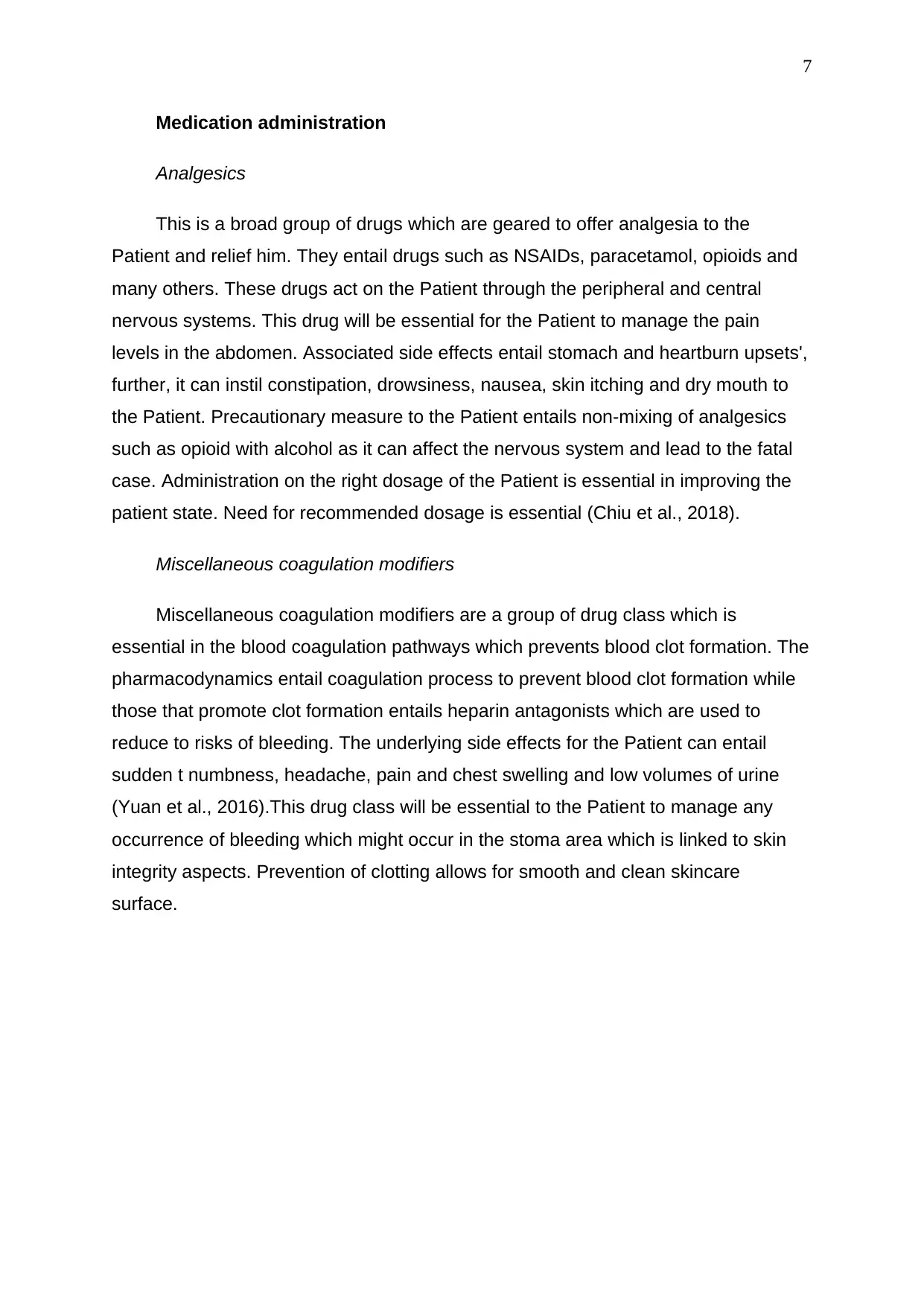
7
Medication administration
Analgesics
This is a broad group of drugs which are geared to offer analgesia to the
Patient and relief him. They entail drugs such as NSAIDs, paracetamol, opioids and
many others. These drugs act on the Patient through the peripheral and central
nervous systems. This drug will be essential for the Patient to manage the pain
levels in the abdomen. Associated side effects entail stomach and heartburn upsets',
further, it can instil constipation, drowsiness, nausea, skin itching and dry mouth to
the Patient. Precautionary measure to the Patient entails non-mixing of analgesics
such as opioid with alcohol as it can affect the nervous system and lead to the fatal
case. Administration on the right dosage of the Patient is essential in improving the
patient state. Need for recommended dosage is essential (Chiu et al., 2018).
Miscellaneous coagulation modifiers
Miscellaneous coagulation modifiers are a group of drug class which is
essential in the blood coagulation pathways which prevents blood clot formation. The
pharmacodynamics entail coagulation process to prevent blood clot formation while
those that promote clot formation entails heparin antagonists which are used to
reduce to risks of bleeding. The underlying side effects for the Patient can entail
sudden t numbness, headache, pain and chest swelling and low volumes of urine
(Yuan et al., 2016).This drug class will be essential to the Patient to manage any
occurrence of bleeding which might occur in the stoma area which is linked to skin
integrity aspects. Prevention of clotting allows for smooth and clean skincare
surface.
Medication administration
Analgesics
This is a broad group of drugs which are geared to offer analgesia to the
Patient and relief him. They entail drugs such as NSAIDs, paracetamol, opioids and
many others. These drugs act on the Patient through the peripheral and central
nervous systems. This drug will be essential for the Patient to manage the pain
levels in the abdomen. Associated side effects entail stomach and heartburn upsets',
further, it can instil constipation, drowsiness, nausea, skin itching and dry mouth to
the Patient. Precautionary measure to the Patient entails non-mixing of analgesics
such as opioid with alcohol as it can affect the nervous system and lead to the fatal
case. Administration on the right dosage of the Patient is essential in improving the
patient state. Need for recommended dosage is essential (Chiu et al., 2018).
Miscellaneous coagulation modifiers
Miscellaneous coagulation modifiers are a group of drug class which is
essential in the blood coagulation pathways which prevents blood clot formation. The
pharmacodynamics entail coagulation process to prevent blood clot formation while
those that promote clot formation entails heparin antagonists which are used to
reduce to risks of bleeding. The underlying side effects for the Patient can entail
sudden t numbness, headache, pain and chest swelling and low volumes of urine
(Yuan et al., 2016).This drug class will be essential to the Patient to manage any
occurrence of bleeding which might occur in the stoma area which is linked to skin
integrity aspects. Prevention of clotting allows for smooth and clean skincare
surface.
Paraphrase This Document
Need a fresh take? Get an instant paraphrase of this document with our AI Paraphraser
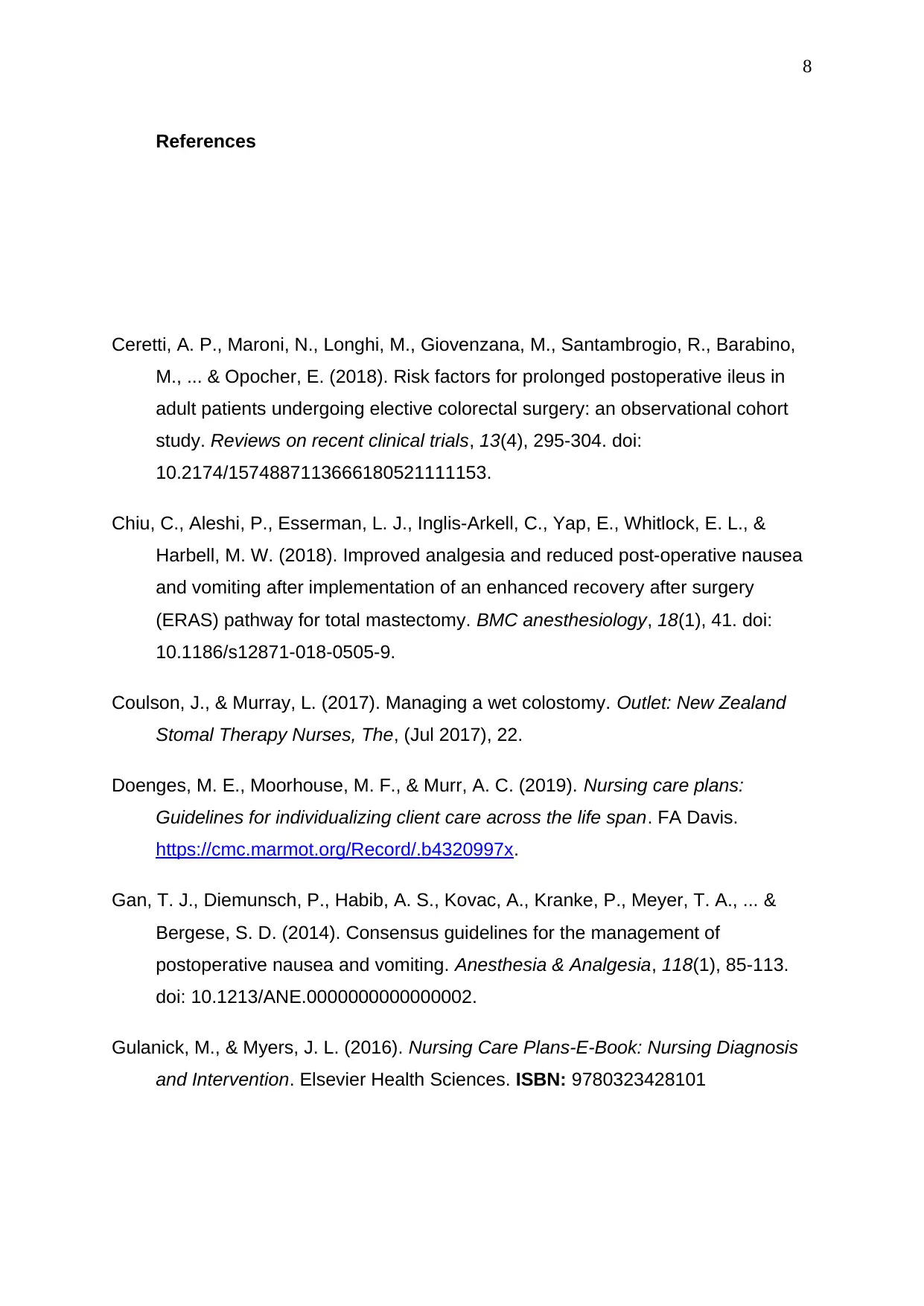
8
References
Ceretti, A. P., Maroni, N., Longhi, M., Giovenzana, M., Santambrogio, R., Barabino,
M., ... & Opocher, E. (2018). Risk factors for prolonged postoperative ileus in
adult patients undergoing elective colorectal surgery: an observational cohort
study. Reviews on recent clinical trials, 13(4), 295-304. doi:
10.2174/1574887113666180521111153.
Chiu, C., Aleshi, P., Esserman, L. J., Inglis-Arkell, C., Yap, E., Whitlock, E. L., &
Harbell, M. W. (2018). Improved analgesia and reduced post-operative nausea
and vomiting after implementation of an enhanced recovery after surgery
(ERAS) pathway for total mastectomy. BMC anesthesiology, 18(1), 41. doi:
10.1186/s12871-018-0505-9.
Coulson, J., & Murray, L. (2017). Managing a wet colostomy. Outlet: New Zealand
Stomal Therapy Nurses, The, (Jul 2017), 22.
Doenges, M. E., Moorhouse, M. F., & Murr, A. C. (2019). Nursing care plans:
Guidelines for individualizing client care across the life span. FA Davis.
https://cmc.marmot.org/Record/.b4320997x.
Gan, T. J., Diemunsch, P., Habib, A. S., Kovac, A., Kranke, P., Meyer, T. A., ... &
Bergese, S. D. (2014). Consensus guidelines for the management of
postoperative nausea and vomiting. Anesthesia & Analgesia, 118(1), 85-113.
doi: 10.1213/ANE.0000000000000002.
Gulanick, M., & Myers, J. L. (2016). Nursing Care Plans-E-Book: Nursing Diagnosis
and Intervention. Elsevier Health Sciences. ISBN: 9780323428101
References
Ceretti, A. P., Maroni, N., Longhi, M., Giovenzana, M., Santambrogio, R., Barabino,
M., ... & Opocher, E. (2018). Risk factors for prolonged postoperative ileus in
adult patients undergoing elective colorectal surgery: an observational cohort
study. Reviews on recent clinical trials, 13(4), 295-304. doi:
10.2174/1574887113666180521111153.
Chiu, C., Aleshi, P., Esserman, L. J., Inglis-Arkell, C., Yap, E., Whitlock, E. L., &
Harbell, M. W. (2018). Improved analgesia and reduced post-operative nausea
and vomiting after implementation of an enhanced recovery after surgery
(ERAS) pathway for total mastectomy. BMC anesthesiology, 18(1), 41. doi:
10.1186/s12871-018-0505-9.
Coulson, J., & Murray, L. (2017). Managing a wet colostomy. Outlet: New Zealand
Stomal Therapy Nurses, The, (Jul 2017), 22.
Doenges, M. E., Moorhouse, M. F., & Murr, A. C. (2019). Nursing care plans:
Guidelines for individualizing client care across the life span. FA Davis.
https://cmc.marmot.org/Record/.b4320997x.
Gan, T. J., Diemunsch, P., Habib, A. S., Kovac, A., Kranke, P., Meyer, T. A., ... &
Bergese, S. D. (2014). Consensus guidelines for the management of
postoperative nausea and vomiting. Anesthesia & Analgesia, 118(1), 85-113.
doi: 10.1213/ANE.0000000000000002.
Gulanick, M., & Myers, J. L. (2016). Nursing Care Plans-E-Book: Nursing Diagnosis
and Intervention. Elsevier Health Sciences. ISBN: 9780323428101
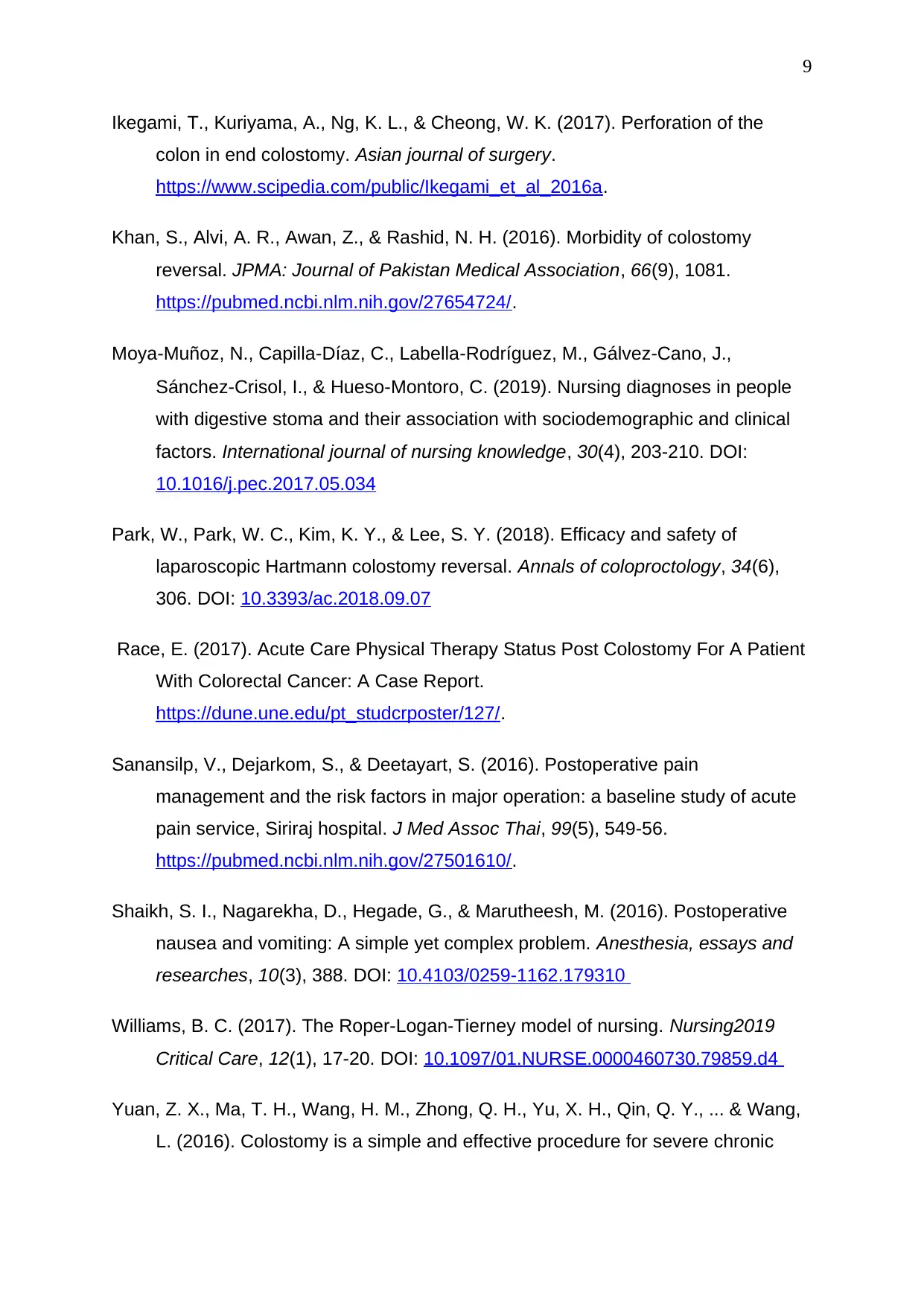
9
Ikegami, T., Kuriyama, A., Ng, K. L., & Cheong, W. K. (2017). Perforation of the
colon in end colostomy. Asian journal of surgery.
https://www.scipedia.com/public/Ikegami_et_al_2016a.
Khan, S., Alvi, A. R., Awan, Z., & Rashid, N. H. (2016). Morbidity of colostomy
reversal. JPMA: Journal of Pakistan Medical Association, 66(9), 1081.
https://pubmed.ncbi.nlm.nih.gov/27654724/.
Moya‐Muñoz, N., Capilla‐Díaz, C., Labella‐Rodríguez, M., Gálvez‐Cano, J.,
Sánchez‐Crisol, I., & Hueso‐Montoro, C. (2019). Nursing diagnoses in people
with digestive stoma and their association with sociodemographic and clinical
factors. International journal of nursing knowledge, 30(4), 203-210. DOI:
10.1016/j.pec.2017.05.034
Park, W., Park, W. C., Kim, K. Y., & Lee, S. Y. (2018). Efficacy and safety of
laparoscopic Hartmann colostomy reversal. Annals of coloproctology, 34(6),
306. DOI: 10.3393/ac.2018.09.07
Race, E. (2017). Acute Care Physical Therapy Status Post Colostomy For A Patient
With Colorectal Cancer: A Case Report.
https://dune.une.edu/pt_studcrposter/127/.
Sanansilp, V., Dejarkom, S., & Deetayart, S. (2016). Postoperative pain
management and the risk factors in major operation: a baseline study of acute
pain service, Siriraj hospital. J Med Assoc Thai, 99(5), 549-56.
https://pubmed.ncbi.nlm.nih.gov/27501610/.
Shaikh, S. I., Nagarekha, D., Hegade, G., & Marutheesh, M. (2016). Postoperative
nausea and vomiting: A simple yet complex problem. Anesthesia, essays and
researches, 10(3), 388. DOI: 10.4103/0259-1162.179310
Williams, B. C. (2017). The Roper-Logan-Tierney model of nursing. Nursing2019
Critical Care, 12(1), 17-20. DOI: 10.1097/01.NURSE.0000460730.79859.d4
Yuan, Z. X., Ma, T. H., Wang, H. M., Zhong, Q. H., Yu, X. H., Qin, Q. Y., ... & Wang,
L. (2016). Colostomy is a simple and effective procedure for severe chronic
Ikegami, T., Kuriyama, A., Ng, K. L., & Cheong, W. K. (2017). Perforation of the
colon in end colostomy. Asian journal of surgery.
https://www.scipedia.com/public/Ikegami_et_al_2016a.
Khan, S., Alvi, A. R., Awan, Z., & Rashid, N. H. (2016). Morbidity of colostomy
reversal. JPMA: Journal of Pakistan Medical Association, 66(9), 1081.
https://pubmed.ncbi.nlm.nih.gov/27654724/.
Moya‐Muñoz, N., Capilla‐Díaz, C., Labella‐Rodríguez, M., Gálvez‐Cano, J.,
Sánchez‐Crisol, I., & Hueso‐Montoro, C. (2019). Nursing diagnoses in people
with digestive stoma and their association with sociodemographic and clinical
factors. International journal of nursing knowledge, 30(4), 203-210. DOI:
10.1016/j.pec.2017.05.034
Park, W., Park, W. C., Kim, K. Y., & Lee, S. Y. (2018). Efficacy and safety of
laparoscopic Hartmann colostomy reversal. Annals of coloproctology, 34(6),
306. DOI: 10.3393/ac.2018.09.07
Race, E. (2017). Acute Care Physical Therapy Status Post Colostomy For A Patient
With Colorectal Cancer: A Case Report.
https://dune.une.edu/pt_studcrposter/127/.
Sanansilp, V., Dejarkom, S., & Deetayart, S. (2016). Postoperative pain
management and the risk factors in major operation: a baseline study of acute
pain service, Siriraj hospital. J Med Assoc Thai, 99(5), 549-56.
https://pubmed.ncbi.nlm.nih.gov/27501610/.
Shaikh, S. I., Nagarekha, D., Hegade, G., & Marutheesh, M. (2016). Postoperative
nausea and vomiting: A simple yet complex problem. Anesthesia, essays and
researches, 10(3), 388. DOI: 10.4103/0259-1162.179310
Williams, B. C. (2017). The Roper-Logan-Tierney model of nursing. Nursing2019
Critical Care, 12(1), 17-20. DOI: 10.1097/01.NURSE.0000460730.79859.d4
Yuan, Z. X., Ma, T. H., Wang, H. M., Zhong, Q. H., Yu, X. H., Qin, Q. Y., ... & Wang,
L. (2016). Colostomy is a simple and effective procedure for severe chronic
⊘ This is a preview!⊘
Do you want full access?
Subscribe today to unlock all pages.

Trusted by 1+ million students worldwide

10
radiation proctitis. World journal of gastroenterology, 22(24), 5598. DOI:
10.3748/wjg.v22.i24.5598 .
radiation proctitis. World journal of gastroenterology, 22(24), 5598. DOI:
10.3748/wjg.v22.i24.5598 .
1 out of 10
Related Documents
Your All-in-One AI-Powered Toolkit for Academic Success.
+13062052269
info@desklib.com
Available 24*7 on WhatsApp / Email
![[object Object]](/_next/static/media/star-bottom.7253800d.svg)
Unlock your academic potential
Copyright © 2020–2025 A2Z Services. All Rights Reserved. Developed and managed by ZUCOL.





